
Ficus benjamina, commonly known as weeping fig, benjamin fig or ficus tree, and often sold in stores as just ficus, is a species of flowering plant in the family Moraceae, native to Asia and Australia. It is the official tree of Bangkok. The species is also naturalized in the West Indies and in the states of Florida and Arizona in the United States. It is one of the most common trees in Israeli cities and parks. In its native range, its small fruit are favored by some birds.
Congea chinensis is a plant in the family Lamiaceae. In Chinese, it is known as 华绒苞藤.
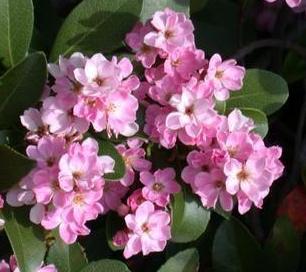
Rhaphiolepis indica, the Indian hawthorn, India hawthorn or Hong Kong hawthorn is an evergreen shrub in the family Rosaceae.

Commelina diffusa, sometimes known as the climbing dayflower or spreading dayflower, is a pantropical herbaceous plant in the dayflower family. It has been introduced to the southeastern United States where it is most common in wet disturbed soils. There are two recognised varieties, one being the type and the other being C. diffusa var. gigas, which is native to Asia and has been introduced to Florida. It flowers from spring to fall and is most common in disturbed situations, moist places and forests. In China the plant is used medicinally as a febrifuge and a diuretic. A blue dye is also extracted from the flower for paints. In the Hawaiian Islands, it is known as "honohono grass", although it is technically not a grass. "Honohono" refers to the alternating structure of the leaves. At least one publication lists it as an edible plant in New Guinea.
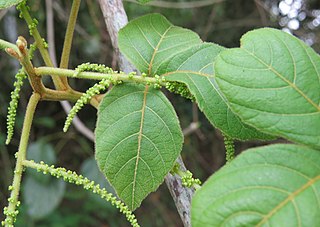
Allophylus cobbe, commonly known as titberry or Indian allophylus, is a pantropical, shrub in the family Sapindaceae with many uses in traditional medicine. It has a highly variable morphology throughout its range and may prove to be more than one species.
Hypodaphnis is a monotypic genus of flowering plants of the family Lauraceae. Its only extant species, Hypodaphnis zenkeri, is native to Gabon. Although only one living species is known, fossils of some species of this genus are present in North America, especially in Northern Mexico. In most phylogenetic analysis, Hypodaphnis appears as the basal branch, the sister group of the rest of the family Lauraceae.

Boerhavia erecta, commonly known as the erect spiderling or the erect boerhavia, is one of more than 100 species in the genus Boerhavia L. Boerhavia erecta is native to the United States, Mexico, Central America and western South America, but now is cosmopolitan in tropical and subtropical regions. In Africa its distribution extends from West Africa, eastwards to Somalia and down to South Africa. It has recently been found in parts of Madagascar and Réunion. In Asia, it occurs in India, Java, Malaysia, the Philippines, China and the Ryukyu Islands.
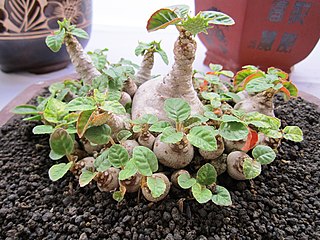
Dorstenia foetida, also known as grendelion, is a succulent plant in the genus Dorstenia, which is native to Eastern Africa and Arabia. It is a very variable species with a wide distribution.

Allophylus decipiens (E.Mey.) Radlk., commonly known as the bastard taaibos, is a multi- or single-stemmed, small, evergreen tree about 3–4 m in height occurring in coastal forest, fringe forest and thickets, and wooded ravines and streams. Found up to 800 m in the southern coastal regions of the Cape Province, KwaZulu-Natal, Eswatini, along the escarpment forest of Mpumalanga, including Soutpansberg and in Mozambique. There are some 219 species in the genus of Allophylus.

Rubus tricolor is an evergreen prostrate shrub, native to southwestern China. Leaves are dark green above, pale green below, and stems have red bristles. It has white flowers in summer and edible red fruit. It grows approximately 0.3 m (0.98 ft) high and usually forming a vigorously spreading, dense mat. In cultivation, it is mainly used as groundcover. Common names include Chinese bramble, groundcover bramble, creeping bramble, Korean raspberry, Himalayan bramble, and groundcover raspberry. In Chinese, it is called 三色莓.
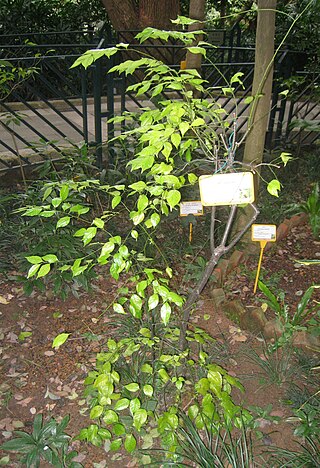
Ilex asprella, also known as rough-leaved holly and plum-leaved holly, is a deciduous shrub native in South East Asia. Ilex asprella is one of the few deciduous species in the family Aquifoliaceae.
Prunus mugus is a species of cherry found in Yunnan province of China and nearby areas of Myanmar and Tibet. A prostrate shrub 1 m tall, it prefers to grow in thickets in the krummholz zone on mountain slopes from 3200 to 3,700 m or even 4,075 m (13,400 ft) above sea level. Heinrich von Handel-Mazzetti, who discovered it, named the species after Pinus mugo, the dwarf mountain pine.
Prunus dictyoneura is a species of bush cherry found in Gansu, Hebei, Henan, Jiangsu, Ningxia, Shaanxi and Shanxi provinces of China. A shrub 0.3 to 1.0 m tall, it prefers to grow in thickets in grasslands on hillsides from 400 to 1600 m above sea level. Chloroplast DNA sequencing has shown that its closest relative is Prunus humilis, at least as far as chloroplasts are concerned.

Castanea seguinii, called Seguin chestnut, Seguin's chestnut, or Chinese chinquapin, and in Chinese: 茅栗, mao li, is a species of chestnut native to south‑central and southeast China.
Syzygium apodophyllum is a tree in the Myrtaceae family endemic to north Queensland. The fruit is edible. It is a host for the exotic plant-pathogen fungus Austropuccinia psidii, which is causing a lot of damage to vegetation communities and economic plants.
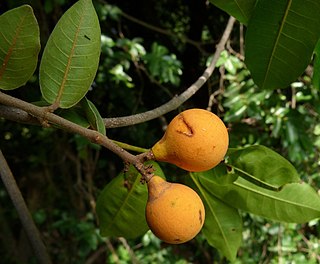
Landolphia heudelotii is a climbing shrub or liana that is within the Apocynaceae family, it occurs in the Guinea and Sudan savannahs of West Africa and cultivated for its rubber and edible fruit.
Landolphia dulcis is a climbing shrub or liana within the Apocynaceae family.

Hewittia malabarica is a flowering plant in the monotypic genus HewittiaWight & Arn., belonging to the family Convolvulaceae and widespread throughout tropical Africa, Asia, and Polynesia. It is a climbing or prostrate perennial herb with slender stems and flowers that are pale yellow, cream, or white with a purple center, and large leaves that can be used as a cooked vegetable or used in folk medicine with the roots. The stems can be used to make ropes.
Zanthoxylum liboense (Chinese: 荔波花椒 is a plant in the Rutaceae family.

Sabia swinhoei, known as Swinhoe's sabia, is a species that belongs to the Sabia genus in the Sabiaceae family. It was first published as a new species in Taiwan in 1886.













